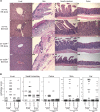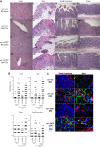CD8+ but not CD4+ T cells require cognate interactions with target tissues to mediate GVHD across only minor H antigens, whereas both CD4+ and CD8+ T cells require direct leukemic contact to mediate GVL
- PMID: 18223170
- PMCID: PMC2275040
- DOI: 10.1182/blood-2007-11-125294
CD8+ but not CD4+ T cells require cognate interactions with target tissues to mediate GVHD across only minor H antigens, whereas both CD4+ and CD8+ T cells require direct leukemic contact to mediate GVL
Abstract
Whether T-cell antigen receptors (TCR) on donor T cells require direct interactions with major histocompatibility complex class I or class II (MHCI/MHCII) molecules on target cells to mediate graft-versus-host disease (GVHD) and graft-versus-leukemia (GVL) is a fundamental question in allogeneic stem-cell transplantation (alloSCT). In MHC-mismatched mouse models, these contacts were not required for GVHD. However, this conclusion may not apply to MHC-matched, multiple minor histocompatibility antigen-mismatched alloSCT, the most common type performed clinically. To address this, we used wild-type (wt)-->MHCI-/- or wt-->MHCII-/- bone marrow chimeras as recipients in GVHD experiments. For GVL experiments, we used MHCI-/- or MHCII-/- chronic-phase CML cells created by expressing the BCR-ABL cDNA in bone marrow from MHCI-/- or MHCII-/- mice. TCR/MHCI contact was obligatory for both CD8-mediated GVHD and GVL. In contrast, CD4 cells induced GVHD in wt-->MHCII-/- chimeras, whereas MHCII-/- mCP-CML was GVL-resistant. Donor CD4 cells infiltrated affected skin and bowel in wt-->MHCII-/- recipients, indicating that they mediated GVHD by acting locally. Thus, CD4 cells use distinct effector mechanisms in GVHD and GVL: direct cytolytic action is required for GVL but not for GVHD. If these noncytolytic pathways can be inhibited, then GVHD might be ameliorated while preserving GVL.
Figures







Similar articles
-
Effector memory CD4+ T cells mediate graft-versus-leukemia without inducing graft-versus-host disease.Blood. 2008 Feb 15;111(4):2476-84. doi: 10.1182/blood-2007-08-109678. Epub 2007 Nov 28. Blood. 2008. PMID: 18045967 Free PMC article.
-
Identification of 4 new HLA-DR-restricted minor histocompatibility antigens as hematopoietic targets in antitumor immunity.Blood. 2009 Oct 22;114(17):3684-92. doi: 10.1182/blood-2009-03-208017. Epub 2009 Aug 25. Blood. 2009. PMID: 19706888
-
Graft-versus-leukemia in a retrovirally induced murine CML model: mechanisms of T-cell killing.Blood. 2004 Jun 1;103(11):4353-61. doi: 10.1182/blood-2003-10-3735. Epub 2004 Feb 24. Blood. 2004. PMID: 14982874
-
[Target antigens for graft-versus-host disease (GVHD) and graft-versus-leukemia/tumor (GVL/T)].Nihon Rinsho. 2003 Sep;61(9):1512-9. Nihon Rinsho. 2003. PMID: 14515717 Review. Japanese.
-
Th2 and Tc2 cells in the regulation of GVHD, GVL, and graft rejection: considerations for the allogeneic transplantation therapy of leukemia and lymphoma.Leuk Lymphoma. 2000 Jul;38(3-4):221-34. doi: 10.3109/10428190009087014. Leuk Lymphoma. 2000. PMID: 10830730 Review.
Cited by
-
Anti-thymocyte globulin for conditioning in matched unrelated donor hematopoietic cell transplantation provides comparable outcomes to matched related donor recipients.Bone Marrow Transplant. 2012 Dec;47(12):1513-9. doi: 10.1038/bmt.2012.81. Epub 2012 May 14. Bone Marrow Transplant. 2012. PMID: 22580767 Free PMC article.
-
Recipient B cells are not required for graft-versus-host disease induction.Biol Blood Marrow Transplant. 2010 Sep;16(9):1222-30. doi: 10.1016/j.bbmt.2010.03.015. Epub 2010 Mar 23. Biol Blood Marrow Transplant. 2010. PMID: 20338255 Free PMC article.
-
Dissecting the biology of allogeneic HSCT to enhance the GvT effect whilst minimizing GvHD.Nat Rev Clin Oncol. 2020 Aug;17(8):475-492. doi: 10.1038/s41571-020-0356-4. Epub 2020 Apr 20. Nat Rev Clin Oncol. 2020. PMID: 32313224 Free PMC article. Review.
-
PD-L1 Prevents the Development of Autoimmune Heart Disease in Graft-versus-Host Disease.J Immunol. 2018 Jan 15;200(2):834-846. doi: 10.4049/jimmunol.1701076. Epub 2017 Dec 6. J Immunol. 2018. PMID: 29212909 Free PMC article.
-
In vivo dynamics of T cells and their interactions with dendritic cells in mouse cutaneous graft-versus-host disease.Blood Adv. 2019 Jul 23;3(14):2082-2092. doi: 10.1182/bloodadvances.2019000227. Blood Adv. 2019. PMID: 31296496 Free PMC article.
References
-
- Mackall CL, Gress RE. Pathways of T-cell regeneration in mice and humans: implications for bone marrow transplantation and immunotherapy. Immunol Rev. 1997;157:61–72. - PubMed
-
- Mackall CL, Hakim FT, Gress RE. Restoration of T-cell homeostasis after T-cell depletion. Semin Immunol. 1997;9:339–346. - PubMed
-
- Bleakley M, Riddell SR. Molecules and mechanisms of the graft-vs-leukaemia effect. Nat Rev Cancer. 2004;4:371–380. - PubMed
-
- Teshima T, Ordemann R, Reddy P, et al. Acute graft-vs-host disease does not require alloantigen expression on host epithelium. Nat Med. 2002;8:575–581. - PubMed
Publication types
MeSH terms
Substances
Grants and funding
LinkOut - more resources
Full Text Sources
Other Literature Sources
Medical
Molecular Biology Databases
Research Materials
Miscellaneous

